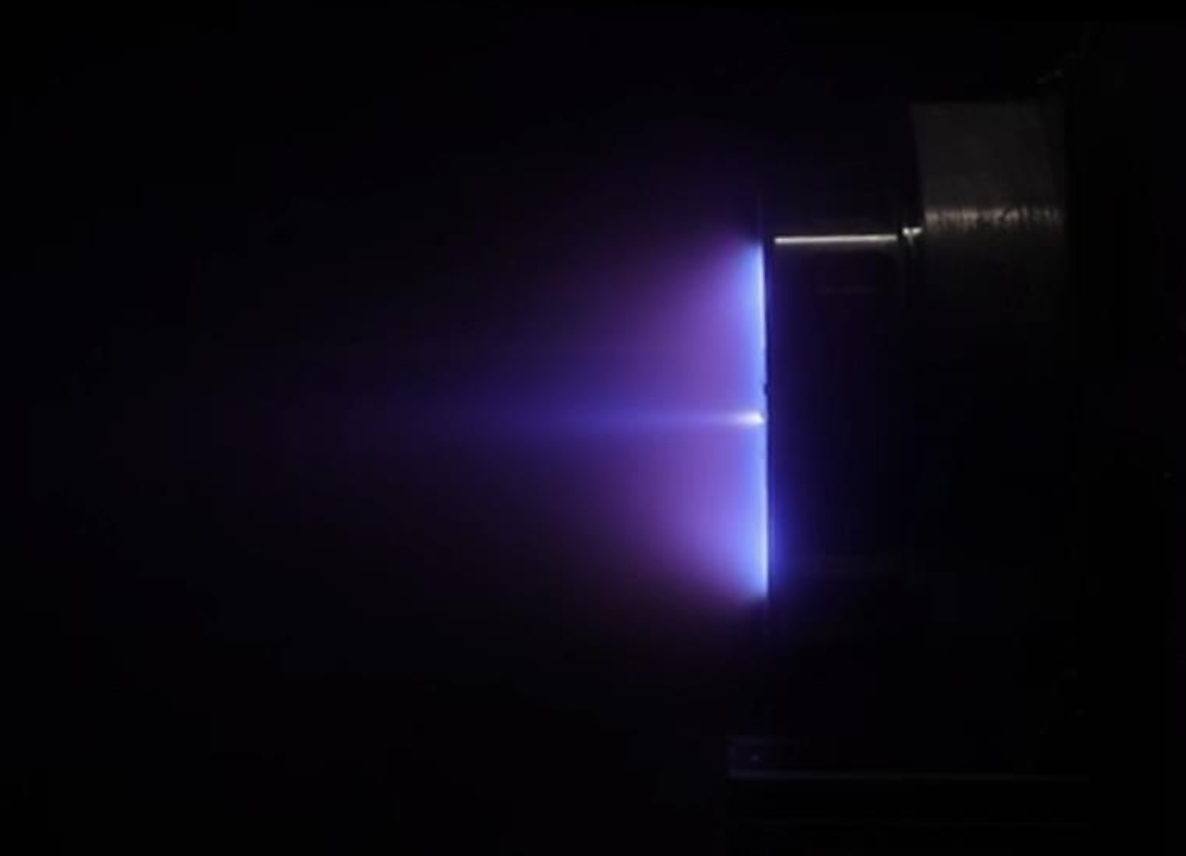Experimental Validation and Achievements from Initial Test Firing with center Cathode.
Author: Pulsar Fusion UK Ltd.
Pulsar Fusion, Bletchley, UK
Abstract
This paper highlights the successful initial test firing of Pulsar Fusion’s first 5kW Hall-effect thruster (HET), conducted in November 2024 as part of the “5kW Testing Project,”. The thruster demonstrated remarkable versatility with both Xenon (Xe) and Krypton (Kr) propellants, achieving a maximum thrust of 104.0 mN, a specific impulse (Isp) of 1891 s, and an anode efficiency peaking at 38.0% within a power range of 2120-2064 W.
The integrated center cathode enabled reliable ignition, while thermal stability was maintained with anode temperatures reaching only 61.7°C. These achievements, documented through low- and high-resolution transient data, underscore Pulsar Fusion’s innovative design and position the thruster as a promising contender for future deep-space propulsion, with ongoing optimization to enhance performance further.
1. Introduction
Hall Effect Thrusters (HETs) are a cornerstone of electric propulsion, offering high specific impulse and efficiency for applications ranging from satellite station-keeping to interplanetary missions. Traditionally, Xenon (Xe) has been the propellant of choice due to its high atomic mass and low ionization energy. However, Krypton (Kr) is gaining attention as a cost-effective alternative, despite its lower performance due to higher ionization energy. This study evaluates the performance of a 500W HET developed by Pulsar Fusion, using Kr as the propellant. The test campaign, conducted on 2–3 July 2025, aimed to characterize thrust, specific impulse (Isp), and anode efficiency across various operating conditions, addressing challenges such as sensor accuracy and operational stability.
2. Experimental Design and Methodology
The test, outlined in the “5kW Testing Specification v0.1.pdf” (dated September 25, 2024), aimed to characterize
basic performance, capture transient data, and conduct a thermal study. The HET was operated with anode voltages
of 106-160 V, powers up to 2120-2064 W, and Kr mass flow rates of 5.61-7.48 mg/s. Thrust, Isp, and efficiency
were measured, supplemented by time-series thermal data from Type K thermocouples, with testing spanning
October 31 to November 15, 2024.
3. Achievements
3.1 Propellant Versatility and Transient Operation
The HET successfully operated with both Xe and Kr, leveraging the integrated center cathode. Transient operation was achieved, with the cathode igniting reliably at 4-10 A, up to 10 V, and 30 sccm, allowing heater power to be turned off post-ignition. This dual-propellant capability highlights the swappable anode’s effectiveness, offering a cost-efficient alternative with Kr and affirming Pulsar’s innovative design approach.
3.2 Thrust Performance
The thruster delivered a maximum thrust of 104.0 mN at 2064 W, 160 V, and a 5.61 mg/s Kr flow, demonstrating robust performance within the tested power range. This result reflects the thruster’s potential to scale thrust with increased power, a promising indicator of its capability to meet future performance targets.
3.3 Specific Impulse
Isp reached an impressive 1891 s under optimal conditions (2064 W, 160 V, 5.61 mg/s), showcasing efficient ion acceleration. This high Isp value positions the thruster competitively among early-stage HET designs, with potential for further enhancement as testing progresses.
3.4 Anode Efficiency
Anode efficiency peaked at 38.0% at 2064 W and 160 V, a significant achievement for initial testing. This upward trend with increasing voltage and power highlights the thruster’s capacity for optimization, laying a strong foundation for achieving higher efficiencies.
3.5 Thermal Stability
Thermal data revealed excellent heat management, with anode temperatures rising from ~20°C to a maximum of 61.7°C and body-mounted temperatures from ~19.8°C to ~54.8°C over the test period (12:40 to 15:55). This stability during startup and steady-state operation underscores the thruster’s robust thermal design.
3.6 Comprehensive Data Collection
The test yielded valuable low-resolution (1 Hz) and high-resolution transient data, capturing the full startup sequence and breathing mode oscillations. This data will inform the development of the power processing unit (PPU), enhancing future operational reliability and efficiency.
4. Discussion
These achievements reflect Pulsar Fusion’s successful initial validation of the 5kW HET design. The ability to operate with both Xe and Kr, coupled with reliable cathode ignition, demonstrates versatility and technological innovation. The recorded thrust, Isp, and efficiency metrics, though obtained at partial power, indicate a strong starting point, with scalability evident in the performance trends. The thermal stability further validates the thruster’s engineering, ensuring durability for extended missions. The comprehensive transient data collection is a testament to Pulsar’s commitment to iterative improvement, positioning the thruster as a leader in next-generation electric propulsion.
5. Conclusion
Pulsar Fusion’s first 5kW HET test firing marks a significant milestone, with positive achievements in propellant versatility, thrust (104.0 mN), specific impulse (1891 s), efficiency (38.0%), thermal stability, and data acquisition. These results highlight the thruster’s potential to advance deep-space propulsion, with ongoing tests at full 5kW power poised to unlock even greater performance. Pulsar Fusion continues to drive innovation, setting the stage for future breakthroughs in space exploration technology.
Acknowledgments
The authors thank the Pulsar team for their support during the test campaign.
References
- “5kW Testing Specification v0.1.pdf,” Pulsar Fusion Ltd, September 25, 2024.
- Performance Data, “Performance data.xlsx,” November 2024.
- Thermal Study Data, “Thermal study.txt,” November 2024.
Pulsar Fusion Technical Report | Code: PF-MOONRANGER-KR/XE-2024
